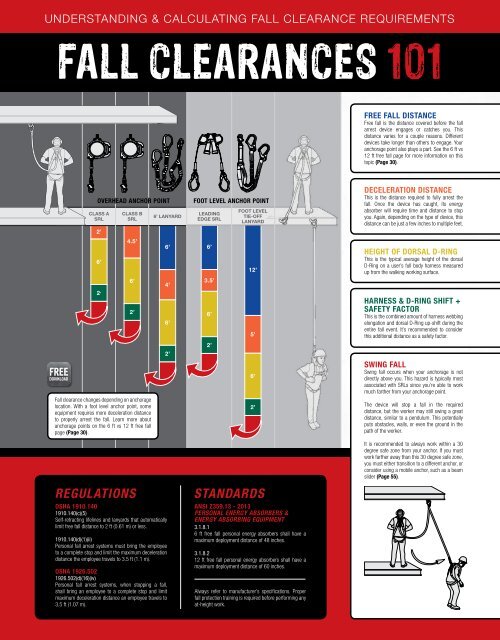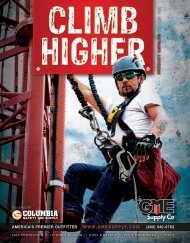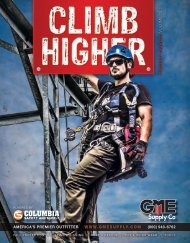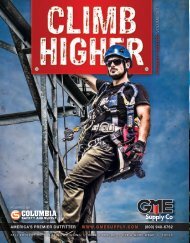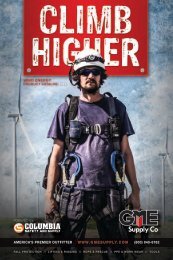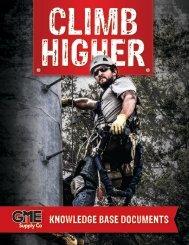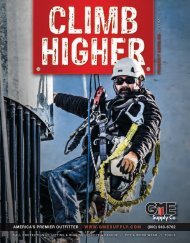GME Supply 2018 Q4 Catalog
GME Supply is North America's premier outfitter of fall protection, safety equipment, and gear for at-height workers, industry, and construction.” Category: knowledge and resources. Tags: catalog, tools, lanyard, harness, ansi, osha, construction, tower, wind, solar, safety, at height, safety equipment, fall protection, GME Supply
GME Supply is North America's premier outfitter of fall protection, safety equipment, and gear for at-height workers, industry, and construction.” Category: knowledge and resources. Tags: catalog, tools, lanyard, harness, ansi, osha, construction, tower, wind, solar, safety, at height, safety equipment, fall protection, GME Supply
Create successful ePaper yourself
Turn your PDF publications into a flip-book with our unique Google optimized e-Paper software.
UNDERSTANDING & CALCULATING FALL CLEARANCE REQUIREMENTS<br />
FALL CLEARANCES 101<br />
FREE FALL DISTANCE<br />
Free fall is the distance covered before the fall<br />
arrest device engages or catches you. This<br />
distance varies for a couple reasons. Different<br />
devices take longer than others to engage. Your<br />
anchorage point also plays a part. See the 6 ft vs<br />
12 ft free fall page for more information on this<br />
topic (Page 30).<br />
POSITIONING // ASSEMBLIES<br />
OVERHEAD ANCHOR POINT<br />
CLASS A<br />
SRL<br />
2’<br />
6’<br />
CLASS B<br />
SRL<br />
4.5’<br />
6’<br />
6’ LANYARD<br />
6’<br />
4’<br />
FOOT LEVEL ANCHOR POINT<br />
LEADING<br />
EDGE SRL<br />
6’<br />
3.5’<br />
FOOT LEVEL<br />
TIE-OFF<br />
LANYARD<br />
12’<br />
Deceleration DISTANCE<br />
This is the distance required to fully arrest the<br />
fall. Once the device has caught, its energy<br />
absorber will require time and distance to stop<br />
you. Again, depending on the type of device, this<br />
distance can be just a few inches to multiple feet.<br />
HEIGHT OF DORSAL D-RING<br />
This is the typical average height of the dorsal<br />
D-Ring on a user’s full body harness measured<br />
up from the walking working surface.<br />
2’<br />
2’<br />
6’<br />
6’<br />
5’<br />
HARNESS & D-RING SHIFT +<br />
SAFETY FACTOR<br />
This is the combined amount of harness webbing<br />
elongation and dorsal D-Ring up-shift during the<br />
entire fall event. It’s recommended to consider<br />
this additional distance as a safety factor.<br />
2’<br />
2’<br />
6’<br />
SWING FALL<br />
Swing fall occurs when your anchorage is not<br />
directly above you. This hazard is typically most<br />
associated with SRLs since you’re able to work<br />
much farther from your anchorage point.<br />
Fall clearance changes depending on anchorage<br />
location. With a foot level anchor point, some<br />
equipment requires more deceleration distance<br />
to properly arrest the fall. Learn more about<br />
anchorage points on the 6 ft vs 12 ft free fall<br />
page (Page 30).<br />
2’<br />
The device will stop a fall in the required<br />
distance, but the worker may still swing a great<br />
distance, similar to a pendulum. This potentially<br />
puts obstacles, walls, or even the ground in the<br />
path of the worker.<br />
It is recommended to always work within a 30<br />
degree safe zone from your anchor. If you must<br />
work farther away than this 30 degree safe zone,<br />
you must either transition to a different anchor, or<br />
consider using a mobile anchor, such as a beam<br />
slider (Page 55).<br />
REGULATIONS<br />
OSHA 1910.140<br />
1910.140(c)(5)<br />
Self-retracting lifelines and lanyards that automatically<br />
limit free fall distance to 2 ft (0.61 m) or less.<br />
1910.140(d)(1)(ii)<br />
Personal fall arrest systems must bring the employee<br />
to a complete stop and limit the maximum deceleration<br />
distance the employee travels to 3.5 ft (1.1 m).<br />
OSHA 1926.502<br />
1926.502(d)(16)(iv)<br />
Personal fall arrest systems, when stopping a fall,<br />
shall bring an employee to a complete stop and limit<br />
maximum deceleration distance an employee travels to<br />
3.5 ft (1.07 m).<br />
STANDARDS<br />
ANSI Z359.13 - 2013<br />
Personal Energy Absorbers &<br />
Energy Absorbing Equipment<br />
3.1.8.1<br />
6 ft free fall personal energy absorbers shall have a<br />
maximum deployment distance of 48 inches.<br />
3.1.8.2<br />
12 ft free fall personal energy absorbers shall have a<br />
maximum deployment distance of 60 inches.<br />
Always refer to manufacturer’s specifications. Proper<br />
fall protection training is required before performing any<br />
at-height work.<br />
(800) 940-6762 43 41


